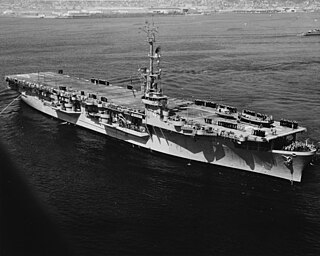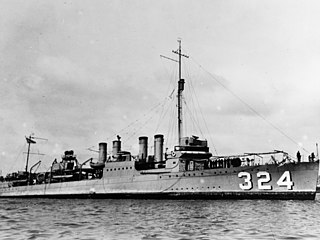
USS Thompson (DD-305), a Clemson-class destroyer of the U.S. Navy named in honor of Secretary of the Navy Richard W. Thompson (1809–1900), never saw action against an enemy. She was the first Navy ship of that name; the second, Thompson (DD-627), named for Robert M. Thompson, served during World War II and the Korean War.

USS Somers (DD-301), a Clemson-class destroyer, engaged in peacetime operations with the Pacific Fleet from 1920 until she was scrapped under the London Naval Treaty in 1930. She was the fourth ship of the United States Navy named for Richard Somers.

USS Newman K. Perry (DD-883/DDR-883), was a Gearing-class destroyer of the United States Navy.

USS Rendova (CVE-114) was a Commencement Bay-class escort carrier of the United States Navy.

The first USS Philip (DD–76) was a Wickes-class destroyer in the United States Navy during World War I, later transferred to the Royal Navy as HMS Lancaster. She was named for John Woodward Philip.

USS Sinclair (DD-275) was a Clemson-class destroyer in the United States Navy. She was named for Captain Arthur Sinclair.

USS Moody (DD-277) was a Clemson-class destroyer in the United States Navy in commission from 1919 to 1922 and from 1923 to 1930. She was named for Justice William Henry Moody.

USS Henshaw (DD-278) was a Clemson-class destroyer in the United States Navy following World War I. She was named for Secretary of the Navy David Henshaw.

The fourth USS Preble (DD-345/DM-20/AG-99) was a Clemson-class destroyer in the United States Navy following World War I, and saw combat in World War II as a minelayer. She was named for Commodore Edward Preble.

USS Stoddert (DD-302/AG-18) was a Clemson-class destroyer in the United States Navy following World War I. She was named for Benjamin Stoddert.
USS Yarborough (DD-314) was a Clemson-class destroyer in the United States Navy.

The first USS Sloat (DD-316) was a Clemson-class destroyer in the United States Navy following World War I. She was named for John Drake Sloat.

The first USS Selfridge (DD-320) was a Clemson-class destroyer in service with the United States Navy from 1921 to 1930. She was scrapped in 1931.

USS Robert Smith (DD-324) was a Clemson-class destroyer in service with the United States Navy from 1921 to 1930. She was scrapped in 1931.

USS Sicard (DD-346/DM-21/AG-100) was a Clemson-class destroyer in the United States Navy following World War I. She was named for Montgomery Sicard.

USS Mount McKinley (AGC-7/LCC-7) was the lead ship of the Mount McKinley class of amphibious force command ships. She was named after the highest mountain in North America. She was designed as an amphibious force flagship, a floating command post with advanced communications equipment and extensive combat information spaces to be used by the amphibious forces commander and landing force commander during large-scale operations.

USS St. Joseph's River was laid down on 19 May 1945 by the Brown Shipbuilding Co., Inc., in Houston, Texas; she was launched on 16 June 1945 and commissioned on 24 August 1945.

The USS Altair (AD-11) was the lead ship of a class of three destroyer tenders. She was named for Altair, the brightest star in the constellation Aquila.

USS Argonne (AP-4/AS-10/AG-31) was a Design 1024 cargo ship built under United States Shipping Board contract by the International Shipbuilding Corp., Hog Island, Pennsylvania, for the United States Department of War. Named Argonne for the U.S. Army's Meuse-Argonne campaign in World War I, she was completed in 1920, delivered to the War Department in December 1920, laid up in February 1921, and loaned to the Navy on 3 November 1921. Accepted preliminarily by the Navy on that date, she was commissioned as Argonne on 8 November 1921 at the Philadelphia Navy Yard. The ship was permanently transferred to the Navy 6 August 1924 by Executive Order.

The first USS Algorma (AT-34) was laid down on 6 January 1919 at Port Richmond, NY, by the Staten Island Shipbuilding Co.; launched on 12 June 1919; and commissioned on 15 May 1920 at the New York Navy Yard, Brooklyn, NY.




















